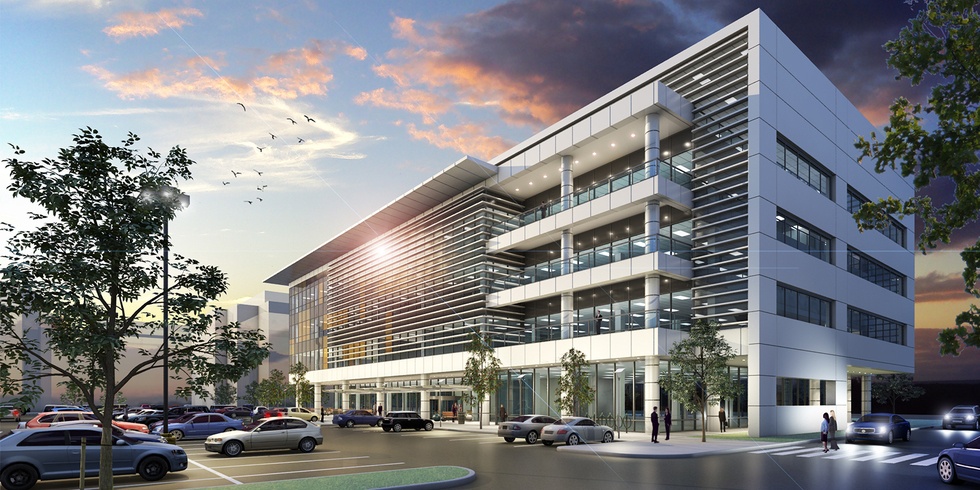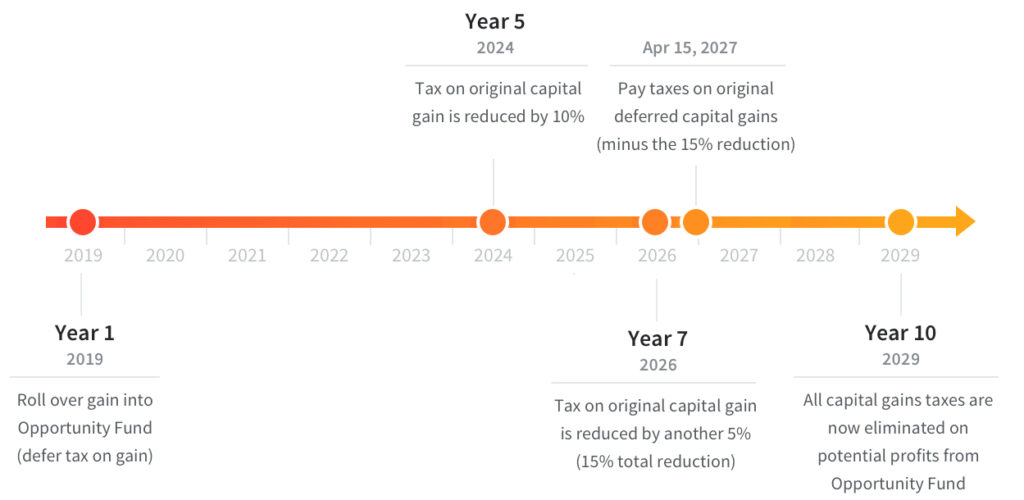
Qualified opportunity zones (QOZ for short) are locations where the Government has incentivized developers to revitalize. They are giving investors a huge tax break for putting their money in these projects.

Here’s a quick breakdown of the benefits for investing in a QOZ. When you sell an asset (stock, bond, real estate) for a profit, that profit is called capital gains. Those gains are then subject to taxes (obviously). However, instead of paying those taxes, you can roll the profits (the gain) into a QOZ fund.
For example, if I made $100,000 from selling an asset, instead of paying the Government $20,000 and reinvesting the $80,000 into something else, I’m able to invest all $100,000 into a QOZ fund. To defer your taxes, you need to reinvest that money into a QOZ fund within 180 days of selling the first asset.
If you hold your money in the fund for 5 years, then the taxes you owe on the original capital gains is reduced by 10%. If you hold if for 7 years then it’s reduced by another 5% (15% total). In this example, if I cashed out of the QOZ fund at year 7, I would only have to pay $17,000 in taxes instead of $20,000.
But if you hold it in the fund for 10 years, then you pay no capital gains taxes on the appreciation of the QOZ asset! So if you bought the building and made all the capital improvements for $5,000,000 and eventually sold it 10 years later for $12,000,000, then you’ll get $7,000,000 tax free!!
Just to clarify, from what I read, only the capital gains from the actual asset in the QOZ fund get’s the tax basis step up (which means you pay no taxes on the capital gains), but it doesn’t mean you don’t need to pay taxes on your original investment (so you still need to pay $17,000). Let me know if I’m mistaken.
With this amazing program, comes amazing players. In the Bay Area, dozens of QOZ funds have been created to redevelop parts of San Jose. The Business Journals have spoken to some of the most prominent investors to get their opinion of the QOZ program and what they plan on doing
Most companies are creating funds in the $20-$250 million range.
One investment fund is looking to purchasing multifamily buildings that have over 20 units to renovate and increase the net operating income. The founder of the fund Taylor Lembi, says that he prefers buildings with high vacancies and that he would rather renovate than build new since a rehab could be completed in a year versus new development which could take 5-7 years.
Another investor is looking to create their own neighborhood with 10 to 12 projects within walking distance of each other. They’ll be small mixed-use properties next to senior assisted living, student housing, and co-living spaces.
Ross Walker the founder of Hawking Way Capital, raised $60 million for their fund. They’ll be turning a parking lot and a small commercial building in Oakland into a hotel with two Marriot brands, a Residence Inn, and an AC Hotel.
The hotel will be located in the Uptown District and will be close to Uptown’s active nightlife and will benefit from the nearby BART station. I don’t go to Oakland that often but it sounds like Uptown is the place to be!
The final investor that was interviewed was J.P. Walsh who is the director of finance for Panoramic Interests.
Their fund is $250 million, and they plan on creating a transit village. The project will take 10 years to complete with an internal rate of return (IRR) in the mid to high teens. If you include the tax benefits from the fund, then the true IRR could be increased by another four to five percentage points to an investor’s after-tax returns.
According to the Business Journal, the transit village will feature 1,032 housing units in three buildings and 44,000 sqft of retail space for 40 small businesses. They’re focused on building student, workforce, and affordable housing, so it won’t be a high end area like Santana Row.
They only have 59 (!) planned parking spots for it’s 3,000 residents. They expect the village to be entirely carless. I’m excited to see how they’re going to pull it off.
The Government incentivizes us to do things by giving us incredible tax benefits if we listen to them. These zones need to be revitalized and I’m a big proponent for the change.
When I went to visit Cincinnati in October of 2018, I was surprised when people told me that ‘The Rhine’ used to be the worst place of the city. It’s currently as bougie as Santana Row!
Yes, there were still some crazy looking people, but they stayed north of one street. It was like an invisible barrier was preventing them from coming to the nice part of ‘The Rhine’.
Some people are claiming that these projects will cause gentrification and will force the people who currently live there to be homeless or forced to move to a bad neighborhood.
It could be possible…but I don’t want to get into the political debate on whether gentrification is good or not.
The QOZ program exists and I believe we’re all better for it.
What are your thoughts? Are you excited to see more development in the Bay Area?
You can view the full article here: https://www.bizjournals.com/sanjose/news/2019/06/20/bay-area-opportunity-zones-urban-catalyst-lembi.html?iana=hpmvp_sjo_news_headline
Clint Coons is one of the founders of Anderson Business Advisors, a firm that specializes in creating asset protection entities…
Justin is a real estate investor who has done almost 2000 deals across the nation and in this episode, he’ll…
David is a real estate investor and a real estate coach. He has been investing in properties for almost 20…
Andrew, a real estate investment developer, is the owner of IronGall Investments, an Austin, Texas-based real estate development company. They…
Chris is the President and CEO of Smart Growth Inc., a California-based real estate and development firm. They are focused…
Rafael is a real estate coach and an organizational psychologist based in Miracle Valley, Arizona. He owns several real estate…